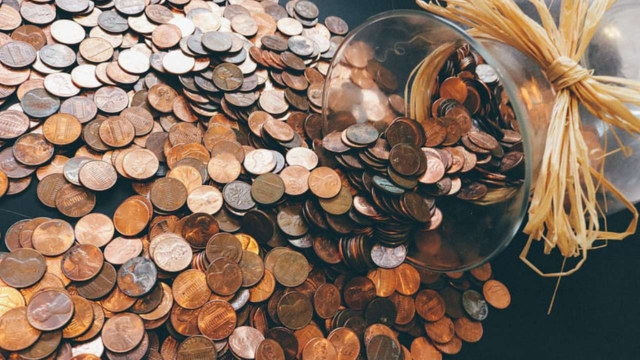The expense of producing the U.S. penny, which has long been a staple of the nation’s monetary system, is causing some anxiety. Currently, it costs the U.S. Mint more than three cents to produce one penny, resulting in an annual deficit. In actuality, the cost of producing pennies alone exceeded $85 million last year. This has sparked debates about whether the United States should cease producing pennies.
In addition to increased production costs, pennies are losing their usefulness. Since many individuals seldom ever spend pennies for daily expenditures, they are frequently tossed away or gathered in jars. There are still over 420 billion pennies in circulation, notwithstanding their low worth. The pennies might not have much of a future, though, according to mounting research.
Some people think that eliminating the penny could simplify transactions and save money, while others have a soft spot for it and wish to keep it in the currency. This article will examine the potential consequences of the United States ceasing to produce pennies.
Pennies’ Financial Issue
The cost of producing pennies is more than their face worth, which has raised serious concerns. The actual worth of a penny is one cent, while the cost to the U.S. government of producing one penny is 3.1 cents. Discussions concerning whether it is financially viable to continue minting pennies have been triggered by this continuous loss.
Here are a few significant statistics:
| Cost to Produce One Penny | 3.1 cents per coin |
| Total Pennies in Circulation | 420 billion coins |
| Annual Production Loss | Over $85 million |
The accompanying table illustrates that taxpayers incur greater expenses than benefits from the manufacture of pennies. The fact that this loss keeps mounting year highlights the necessity of reassessing the penny’s position in the American economy.
If the United States stopped producing pennies, what would happen?
There could be a number of positive and negative changes if the US decided to stop producing pennies. It would have an impact on how people think about money, how the economy functions, and even how they make daily purchases. For instance, prices may be rounded to facilitate and expedite payment.
Those who are accustomed to utilizing pennies, however, could find this confusing. It might take some time for customers to adjust to the shift, and stores would have to modify their systems. Because there would be fewer coins in circulation, more individuals might start using digital payments.
Advantages of Eliminating the Penny
Proponents of eliminating the penny think that there may be a number of advantages, particularly in terms of financial savings, payment convenience, and promoting digital payments. Some of the primary benefits they recommend are listed below:
Savings on expenses
The United States might save millions of dollars annually if the penny were abolished. Stopping the minting of pennies would allow the money saved to be used for other essential services or needs, including infrastructure, healthcare, or education.
Pricing Simplified
Prices would most likely be rounded to the nearest five cents if there were no pennies in circulation. Because there would be no need for minor adjustments, this modification might make purchasing goods and services faster and simpler. This could cut down on the time spent handling and counting coins for both patrons and store owners.
Transition to Electronic Payments
People may begin to rely more on digital payment methods, such as credit cards, smartphone apps, or even electronic money, if they are using fewer cents. By encouraging more people to embrace cashless payment methods, the decrease of real coins may help make transactions even more practical and effective in today’s society.
Economic Impact
While the removal of the penny could generate savings and simplify transactions, there are still questions about how it would affect various sectors of the economy.
- Retailers: Retailers could benefit from reduced transaction times and simpler pricing. However, they might need to adjust their systems to accommodate rounding prices at the register.
- Collecting and Nostalgia: Despite its reduced purchasing power, the penny remains a valuable collectable for numismatists. The removal of the coin could increase its rarity and demand among collectors, potentially driving up its value in the long term.
Arguments for Keeping the Penny
There are still compelling reasons to retain the penny in use despite the benefits of doing away with it. Let’s examine the primary arguments made by some for keeping the penny in the US money system.
Historical and Cultural Significance
For more than 150 years, the penny has been a part of American culture. It is seen by many as a representation of the history and ideals of the nation. Because of their attachment to the penny, some individuals fear that its removal would mean that a part of America’s history will be lost.
The penny is still used in the money system even though it is worth very little now. It stands for the concept of “making change,” which has long been significant in the American economy.
Effect on Donations to Charities
Pennies are a common source of funding for charitable groups. People frequently give little sums of change to causes that are important to them. Some fear that this source of modest gifts would disappear if pennies were eliminated.
Opinion of the Public
Regarding the removal of the penny, opinions among the public are divided. Some people are firmly against the notion, while others are in favor of it. Even though they aren’t used very much, many people still encounter the penny in their daily lives. Some people believe that discarding the penny is equivalent to taking away something that is more significant than its meager worth.
Possible Substitutes for Elimination
There are a few alternatives that can be taken into consideration in place of abolishing the penny entirely. One suggestion is for the U.S. Mint to create fewer pennies annually. This would reduce expenses without completely doing away with the pennies by concentrating on making only the most essential coins.
Implementing a rounding system at the point of sale is an additional choice. People might still identify the coin with value even if real pennies were no longer necessary since prices could be rounded to the nearest five cents. These substitutes might aid in resolving the penny’s problems while preserving some of its symbolic value.




